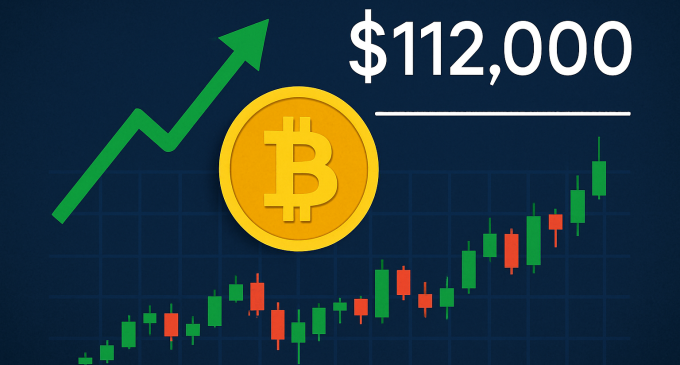
Introduction
Bitcoin, the world’s most valuable and widely recognized cryptocurrency, has made headlines once again by reaching an all-time intraday high of nearly $112,000. After a brief pullback, it currently trades around $111,150, signaling strong investor confidence and an accelerating bullish trend in the digital asset market. This milestone is not just a psychological breakthrough but also a clear reflection of macroeconomic shifts, growing institutional involvement, and evolving regulatory landscapes across the globe.
This historic moment has reignited conversations about Bitcoin’s role as both a speculative asset and a long-term store of value. Over the past few years, Bitcoin has transitioned from a niche digital currency favored by tech enthusiasts and libertarians into a core portfolio component for institutional investors, hedge funds, and even sovereign entities. Today’s rally reflects more than price momentum; it underscores a broader paradigm shift in how global markets are interpreting risk, opportunity, and innovation.
The Journey To $112,000: A New Milestone In Bitcoin’s Evolution
Bitcoin’s meteoric rise from its humble beginnings to a five-figure price point has been nothing short of extraordinary. Initially launched in 2009 by the mysterious Satoshi Nakamoto, Bitcoin was envisioned as a decentralized alternative to traditional fiat currencies. It operated outside central banks’ control and relied on blockchain technology to facilitate secure peer-to-peer transactions.
Over the years, Bitcoin’s value has been shaped by numerous catalysts: technological advancements, speculative booms, media narratives, regulatory decisions, and shifting public perceptions. Each price surge has been marked by a distinct phase in Bitcoin’s evolution, from the Silk Road days to the retail frenzy of 2017 and the institutional wave that began in 2020.
The current rally pushing Bitcoin to nearly $112,000 appears fundamentally different from previous cycles. It is driven not just by hype or fear of missing out, but by concrete financial integration and global acceptance. Central banks, hedge funds, corporate treasuries, and even governments are now acknowledging Bitcoin’s significance in the global financial system.
Institutional Adoption And Strategic Accumulation
Perhaps the most defining feature of Bitcoin’s current bull run is the scale of institutional adoption. No longer a fringe asset, Bitcoin has found its way into the portfolios of some of the world’s largest and most risk-conscious financial institutions.
From BlackRock and Fidelity to Goldman Sachs and JPMorgan, traditional finance players are increasingly offering crypto investment products, establishing custody services, and allocating capital to Bitcoin-backed funds. Even more significantly, U.S. and European pension funds have begun treating Bitcoin as a hedge against inflation and currency depreciation, joining the ranks of early adopters like MicroStrategy and Tesla.
Large-scale accumulation by these entities has introduced a degree of price stability that was absent in previous rallies. With institutions holding long-term positions and reducing the available liquid supply, upward price pressure becomes more persistent. Unlike retail traders who may panic sell during corrections, institutional investors are more likely to buy dips and hold through volatility, contributing to sustained bullish momentum.
Macroeconomic Factors Fueling The Rally
Bitcoin’s rise to nearly $112,000 has not occurred in a vacuum. Broader macroeconomic conditions have significantly influenced investor sentiment and asset allocation strategies.
The global economy in 2025 continues to navigate the aftershocks of the COVID-19 pandemic, geopolitical instability, and rising inflation. Central banks around the world, including the U.S. Federal Reserve, have adopted aggressive monetary policies over the past five years, flooding the market with liquidity and keeping interest rates historically low. While these measures were intended to stabilize economies, they have also led to asset bubbles and concerns about currency devaluation.
In such an environment, Bitcoin’s appeal as a non-sovereign, deflationary asset has grown stronger. Investors increasingly view Bitcoin as “digital gold”—a modern store of value that offers protection against inflation, political risk, and centralized monetary mismanagement.
Additionally, the declining confidence in fiat currencies and the weakening of major global reserve currencies have led to renewed interest in decentralized alternatives. Bitcoin’s fixed supply of 21 million coins and its transparent issuance schedule stand in stark contrast to the unpredictable monetary policies of central banks, making it an attractive option for those seeking long-term financial security.
Technological Developments And Ecosystem Growth
The Bitcoin network itself has undergone significant improvements in recent years, contributing to increased adoption and functionality. Layer-2 solutions such as the Lightning Network have made Bitcoin transactions faster and cheaper, addressing one of the network’s long-standing scalability issues.
At the same time, Bitcoin’s role in decentralized finance (DeFi) has expanded. Wrapped Bitcoin and other interoperability tools now allow BTC to be used on alternative blockchains like Ethereum and Solana, increasing its utility and integrating it more deeply into the broader crypto ecosystem.
Moreover, institutional-grade infrastructure has matured considerably. Custodial solutions are more secure, regulatory frameworks are clearer in many jurisdictions, and exchanges have become more robust and compliant. These developments reduce operational and legal risks for large investors, encouraging more capital to flow into Bitcoin.
Regulatory Clarity And Government Involvement
Another contributing factor to Bitcoin’s record-breaking rally is the increasing clarity around crypto regulation. While regulatory environments remain inconsistent across different regions, key markets like the United States, European Union, and parts of Asia have made substantial progress in establishing legal frameworks for digital assets.
In the U.S., the Securities and Exchange Commission (SEC) and Commodity Futures Trading Commission (CFTC) have outlined clearer rules for crypto exchanges and digital asset classifications. Recent legislative efforts, such as the Financial Innovation and Technology Act, aim to create a cohesive national framework for digital assets, reducing uncertainty and legal gray areas.
This improved clarity has not only encouraged private sector investment but also facilitated public sector participation. Several governments have begun exploring central bank digital currencies (CBDCs), while others are experimenting with blockchain for public services and finance. In a landmark move, the U.S. Treasury recently disclosed its establishment of a Strategic Bitcoin Reserve, holding tens of billions of dollars worth of BTC seized from past enforcement actions. This marks the first formal governmental recognition of Bitcoin as a sovereign asset.
Global Demand And Market Liquidity
Bitcoin’s current rally also reflects increased global demand, particularly from emerging markets. In countries experiencing currency instability, hyperinflation, or economic sanctions, Bitcoin offers a viable alternative to traditional banking and savings systems. Nations such as Argentina, Turkey, and Nigeria have seen a surge in peer-to-peer Bitcoin activity as citizens seek to protect their wealth.
At the same time, growing liquidity across both spot and derivatives markets has made Bitcoin more accessible to traders and investors of all sizes. The approval of Bitcoin spot exchange-traded funds (ETFs) in multiple jurisdictions has further enhanced accessibility, allowing investors to gain exposure to Bitcoin without holding the asset directly.
These ETFs attract not only institutional players but also retail investors and financial advisors, creating a more diversified and resilient market. Liquidity on centralized exchanges has increased, while decentralized platforms are also experiencing growth, offering alternatives that align with Bitcoin’s original ethos of decentralization.
Media Narrative And Social Influence
Media coverage and public perception have always played a role in Bitcoin’s price trajectory. The current cycle has benefited from overwhelmingly positive media narratives and celebrity endorsements. Influential voices from the finance and tech sectors regularly express bullish views on Bitcoin, reinforcing its legitimacy and mainstream status.
Social media platforms such as Twitter, YouTube, and Reddit remain crucial arenas for Bitcoin discussion, education, and advocacy. As more influencers and thought leaders align themselves with Bitcoin, its credibility as a global asset class continues to strengthen.
Unlike previous cycles characterized by misinformation and speculation, the current discourse around Bitcoin is more sophisticated. Discussions are now focused on macroeconomics, technology, geopolitics, and portfolio strategy rather than just price speculation. This intellectual maturity has contributed to more sustainable adoption and less speculative volatility.
Volatility, Corrections, And Long-Term Outlook
Despite its recent success, Bitcoin remains a volatile asset, and corrections are inevitable. While institutional adoption and market maturity have reduced some of Bitcoin’s wild price swings, significant drawdowns still occur. Investors must be prepared for price fluctuations and maintain a long-term perspective.
However, the long-term outlook for Bitcoin remains overwhelmingly positive. Analysts predict further price appreciation driven by continued institutional interest, growing retail adoption, and macroeconomic factors favoring deflationary assets. Some projections even suggest that Bitcoin could reach $150,000 to $200,000 within the next 12 to 18 months, depending on market conditions and regulatory developments.
Moreover, Bitcoin’s increasing integration into global financial systems points to its resilience and adaptability. It is no longer just a digital experiment but a foundational layer in the future of finance. Whether used as a hedge, a settlement network, or a new standard for value storage, Bitcoin’s utility is expanding across multiple dimensions.
The Psychological Impact Of Breaking $100,000
Breaking the $100,000 barrier was more than just a numerical milestone—it was a psychological breakthrough. It cemented Bitcoin’s status as a heavyweight financial asset and erased lingering doubts about its viability. Investors who were previously skeptical or hesitant have now taken notice, and many are reconsidering their portfolio allocations.
This price point also validates the predictions of early adopters and Bitcoin evangelists who have long maintained that its value would eventually reflect its utility and scarcity. The achievement of a six-figure valuation has silenced many critics and created a new benchmark for success in the crypto space.
More importantly, this moment has inspired a new generation of investors and technologists who see Bitcoin not only as a financial instrument but as a symbol of innovation, resistance, and empowerment. It is reshaping how people think about money, ownership, and freedom.
Conclusion
As Bitcoin stabilizes near $111,150 after peaking close to $112,000, the crypto landscape stands on the brink of a new era. This record-breaking rally is a testament to Bitcoin’s resilience, growing adoption, and undeniable relevance in the global financial system.
While short-term volatility remains a factor, the long-term case for Bitcoin has never been stronger. With continued institutional support, technological innovation, and expanding global demand, Bitcoin is poised to maintain its trajectory as a leading store of value and a transformative force in modern finance.
The road ahead may be filled with regulatory challenges, macroeconomic shifts, and competitive pressures, but Bitcoin has already proven its ability to evolve and thrive. Whether you are a retail investor, an institutional fund manager, or a policymaker, Bitcoin’s rise to $112,000 is a signal that the future of finance is being written today—and Bitcoin is at the center of that story.







There are no comments at the moment, do you want to add one?
Write a comment